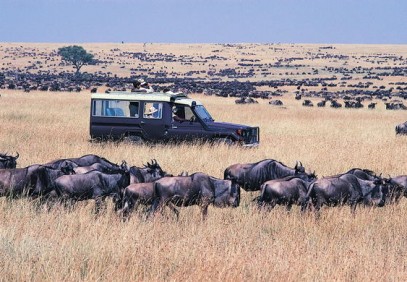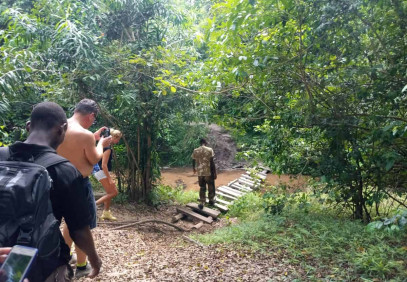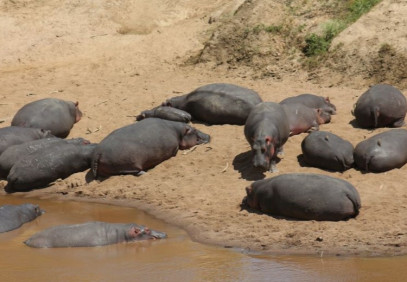Buffalo Springs National Reserve
Buffalo Springs National Reserve and Samburu National Reserve share an ecosystem and are located on the opposite banks of the Ewaso Nyiro River. Buffalo Springs covers an area of 131 square kilometres, which is almost in line with Samburu National Reserve’s area of 165 square kilometres.
Buffalo Springs has several landmarks, one of which is the centuries-old volcano Champagne Ridge – a popular safari attraction. The reserve’s name is derived from the natural springs that are fed by the underground water. These springs provide a rich water source even during the driest months, attracting animals such as Rothschild’s giraffe, Grevy’s zebras, and predators. The region is semi-arid and can be especially dry during the peak safari season.
Diverse Vegetation at Buffalo Springs National Reserve
Buffalo Springs National Reserve has several types of vegetation, ranging from open woodlands to riverine forest. The Ewaso Ng’iro River is surrounded by riverine forests. The reserve also has toothbrush trees, which is the prefered diet for the healthy elephant population. The trees are also used by the locals as toothbrushes, hence the name.
The regions with woodlands are dominated by the Acacia woodlands and bushlands. Visitors can take guided nature walks into the bushlands, an ideal way to spot rare birds. The walks are either led by knowledgeable locals or game rangers.
Wildlife at Buffalo Springs National Reserve
Buffalo Springs has a healthy wildlife population, including four of the big five (there are no rhinos). The reserve’s habituated leopards are easier to spot here as well as other wildlife including.
Beisa oryx, reticulated giraffe, hippos, gerenuk, greater kudu, lesser kudu, Burchell’s zebra, and Grevy’s zebras, which are plentiful and can be commonly seen grazing in the reserve. Visitors will be able to spot gerenuk, who stand up on their hind legs to reach leaves that are out of reach. Referred to as giraffe gazelle, its unusually long neck paired with a gazelle-like body is easily identifiable. Waterbuck can be seen on the banks of Ewaso Ng’iro River, home to crocodiles which spend a lot of time basking on the sandbars.
Among the predators, lions are more elusive than the leopards in Buffalo Springs National Reserve and there are a large number of striped hyenas.
The reserve has several species of sunbirds, sparrows, larks, and starlings, such as black-bellied sunbird, Hunter’s Sunbird, pink-breasted lark, red-winged Lark, singing bush lark, bristle-crowned starling, and golden-breasted starling. It is also home to rare species such as Somali ostrich and vulturine guinea-fowl.
When to Visit Buffalo Springs National Reserve
During the wet season, the reserve is lush and full of water sources making animals disperse and difficult to spot. So, the best time to visit the Buffalo Springs National Reserve is either from June to October or December to March (dry season). Although November to April is a good time for bird watching, the game reserve remains inaccessible due to incessant rainfall. Visitors can plan a trip during the dry season to spot the resident bird species while to spot the migratory species, bird enthusiasts should visit during October and November when the species arrive in the reserve.
Login to your account
Register as a traveller if you are looking for deals
Register as a travel partner if you offer amazing safaris
You May Also Be Interested In...

Chyulu Hills National Park
Dubbed the "Green Hills of Africa", the breathtaking scenery is the central attraction of the Chyulu Hills National Park located in the Makueni county of southeastern Kenya. Established in 1983, Chyulu...

Nairobi National Park
Typically, most wildlife reserves and national parks are located in remote locations away from the hubbub of cities. However, Nairobi National Park, one of Kenya’s popular safari destinations, bucks...

Tsavo East National Park
Tsavo East National Park covers 13,700 square kilometres of Kenya, which is nine times the size of Masai Mara National Reserve. Tsavo National Park refers to both Tsavo East and West National Park, which...

Samburu National Reserve
Covering an expanse of 165 km2 along the banks of river Ewaso Ng'iro, Kenya stands an iconic safari destination; the Samburu National Reserve. The park is situated in the vicinity of the Buffalo Springs...

Meru National Park
Meru National Park, covering an area of 870.44 km2, is a remote national park in Kenya, Africa. This wild and beautiful park has diverse landscapes, which include open plains bordered by riverbanks, slopes...

Amboseli National Park
Amboseli National Park, covering an area of 392 km2, has a unique ecosystem with a mixture of swamps and arid areas. Acacia woodlands, marshlands, open plains and rocky-thornbush are four of the five naturally...

Maasai Mara National Reserve
The Maasai Mara National Reserve in the southwest of Kenya covers an area of 1,510 square kilometres and consists mainly of open grasslands with clumps of acacia trees. One of Africa's most famous national...












